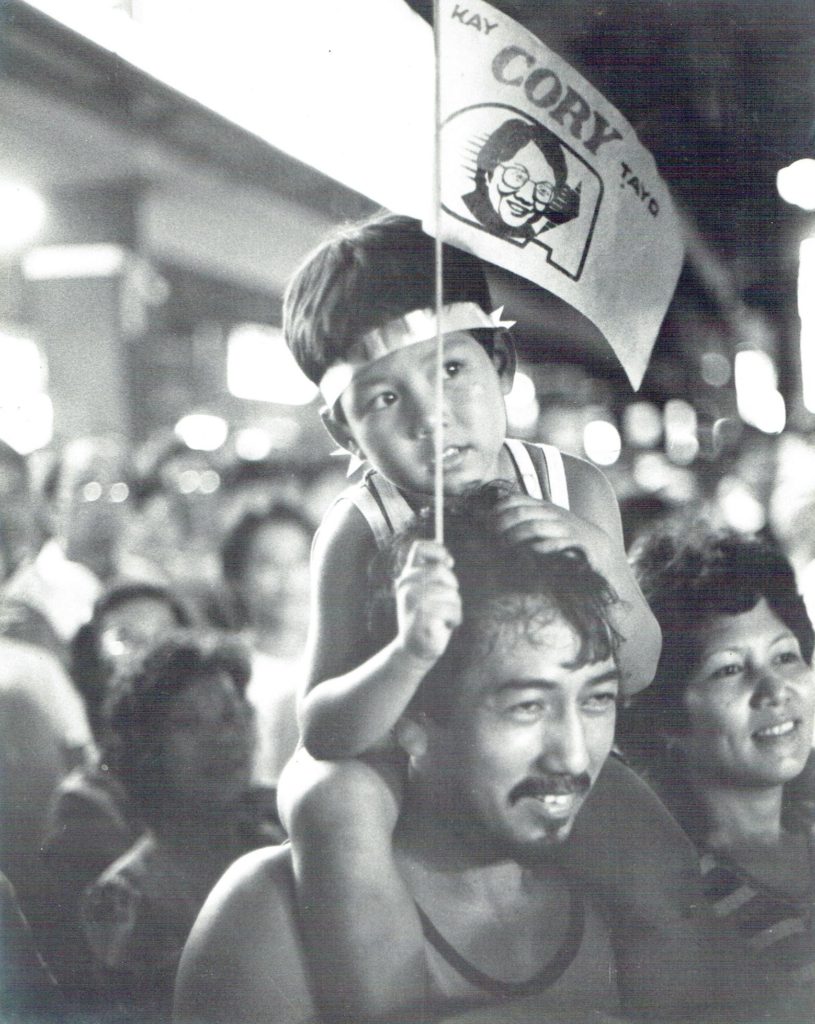EDSA ’86 — Aquino vs. Marcos lang daw ?!?
SABI-SABI NG MGA MARCOS #1
Ang EDSA daw ay hindi pag-aalsa laban kay Marcos nung 1986. Ang EDSA daw ay laban lang ng dalawang political families: Aquino vs Marcos.
HINDI TOTOO.
Ang EDSA ay pag-aalsa ng taongbayan kontra-Marcos nang dinaya ni Marcos ang snap election.
Dati nang gawi ni Marcos ang pandaraya sa mga referendum at eleksyon in the 14 years of Martial Law – lutong Makoy, ika nga.
Yung 1986 snap election ang naging last straw. Agad kasing napatunayan ng taongbayan na may nagaganap na dayaan nung mag-walk-out ang computer technicians ng COMELEC — iba daw ang vote-count nila sa vote-count na ibinibigay sa mga media na hawak ni Marcos.
Balita pa ng NAMFREL, sa mga balwarte ng Oposisyon may tatlong milyong rehistradong botante ang hindi nakaboto – nag-disappear na lang ang names nila sa voters’ lists. Icing on the cake na lang ang confession ni Enrile nung Feb 22 na dinaya nila si Cory sa Cagayan.
Taongbayan na dinaya ang kalaban ni Marcos noong EDSA.
Taongbayan na sawang-sawa na sa panunupil at korapsyon ang nanindigan laban kay Marcos noong EDSA.
KUNG AWAY-PAMILYA LANG ang kina Marcos at Ninoy … gusto lang ni Marcos na mapatahimik si Ninoy … bakit buong bansa ang isinailalim sa Martial Law?
Kung si Ninoy lang ang problema, bakit umabot si Marcos sa Proclamation 1081 at Batas Militar?
ANG TOTOO: Ang goal talaga ni Marcos ay mamuno sa Pilipinas habangbuhay. Bagong Lipunan = Marcos Dynasty. Marcos Forever. Pagkatapos niya, si Imelda. At pag-ready na, si Imee. Na puwede lang mangyari kung walang Ninoy at kung tuloy-tuloy ang Batas Militar.
Pero dahil may isang astig na Ninoy Aquino na nanindigan laban sa diktador, na siya niyang ikinamatay, lalong namulat ang taongbayan sa tapang at kabayanihan ni Ninoy at sa kalupitan, panunupil, at panlilinlang ng rehimeng Marcos.
ANG TAONGBAYAN AT SI CORY
Taongbayan na mulat sa demokrasya at kalayaan ang nag-udyok kay Cory na tumakbong pangulo noong 1986.
At nang dayain ni Marcos ang snap election, taongbayan ang nagbigay-buhay sa crony boycott ni Cory. Ika-pitong araw na ng boykot nang mag-defect sina Enrile at Ramos. [Humahabol much?]
Sa kainitang iyon ng boykot, parang hulog ng langit ang datíng ng military defection. Wow. May armed forces na si Cory?!? Agad sumaklolo sa EDSA ang taongbayan.
Ayun pala, hindi type ni Cory ang dalawang bandido, and vice versa,
Si Ramos ang nagpa-aresto kay Ninoy close to midnight of September 22 1972. Si Enrile ang “jailer” ni Ninoy 1972-1980.
Kung si Cory ang nasunod noong nag-defect sina Enrile, sa Luneta niya yinaya ang supporters niya, hindi sa EDSA. Mas gusto niya sanang manood lang from the sidelines habang nagbabanatan at nagpapatayan ang puwersang repormista at puwersang loyalista. [Imagine. What if.]
Pero napangunahan ng taongbayan si Cory. Sumusugod na sila sa EDSA nang nabalitaan ni Cory ang defection. Humaharang na sila sa tangke nang bumalik si Cory from Cebu.
PEOPLE POWER
Sa huli, nang kumaripas ng takbo ang mga Marcos, hindi ito dala ng takot sa lumalakas na armadong puwersa ng kaaway – nagmamadali silang umexit dala ng matinding takot sa (unarmed) People Power na nagbabadya sa gates ng Malacañang.
People Power din, na nagbabadya sa gates ng Clark Air Base, ang ikinatakot ni Gen. Teddy Allen kaya siya humingi ng permiso sa Washington DC na ilipad paalis ng Pinas, sa lalong madaling panahon, ang barkadang Marcos-Danding-Ver.
Ibang klase ang powers ng taongbayan kapag mulat, maraming marami, at nagkakaisa. Walang armas, pero matapang at umaasinta. Who knows what People Power can do? Or make happen?
Iyan ang fear ni Marcos nung Pebrero 25 1986. Hindi na siya in-control. Mabigat ang kalaban. Anything could happen. Kaya sila tumakbo.
BLACK PROP
Siyempre baliktad ang version of the story ng Marcos heirs. Wala-lang daw ang EDSA, pulitika lang, away ng dalawang pamilya, kinidnap nga sila, kawawa naman sila.
Ang kakapal.
Ang kampanya ni Marcos Jr. is built on huge lies that paint the Marcoses all good and the Aquinos and EDSA all evil.
Anything to justify a return to the Palace.
Grabe ang riches at stake, ill-gotten and all.
Worth na worth lying for, in the Marcos playbook.
*
read the marcos curse https://stuartsantiago.com/the-marcos-curse-
